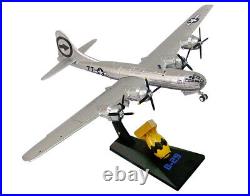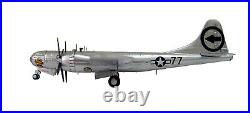


I have become death, the destroyer of worlds. Atomic Bomb Scientist Robert Oppenheimer, reciting a text from an ancient Hindu scripture after witnessing the Trinity test explosion. The Boeing B-29 Superfortress (Boeing Model 341/345) was a four-engine heavy bomber flown by the United States Army Air Force. It was one of the largest aircraft of World War II to see active service. When it entered service, it was one of the most advanced bombers of its time, featuring innovations such as a pressurized cabin, a central fire-control system, and remote-controlled machine gun turrets. It was designed to be a high altitude daytime bomber, but was most used in low-altitude night time incendiary bombing. It was the primary weapons platform used in the United States fire-bombing campaign against Japan in the final months of World War II, and B-29s carried the atomic bombs that destroyed Hiroshima and Nagasaki. Unlike many other bombers, the B-29 remained in service long after World War II ended, a few being employed as flying television transmitters for Stratovision. By the time it was retired in the 1960s, some 3,900 planes had been built. Pictured here is a 1:144 scale replica of the USAAF Boeing B-29 Superfortress nicknamed “Bock’s Car, ” which dropped the atomic bomb’Little Boy’ on Hiroshima on August 6th, 1945. Comes with 1:72 scale replica of the “Fat Man” atomic bomb. Dimensions: Wingspan: 12-inches Length: 8-inches. Features: – Diecast construction – Includes a 1:72 scale replica of the “Fat Man” atomic bomb – Plexiglass canopy – Spinning propellers – Accurate markings and insignia – Comes with display stand. Historical Account: “Bock’s Car” – Bockscar, sometimes called Bock’s Car, is the name of the United States Army Air Forces B-29 bomber that dropped a Fat Man nuclear weapon over the Japanese city of Nagasaki during World War II in the second – and last – nuclear attack in history. One of 15 Silverplate B-29s used by the 509th, Bockscar was built at the Glenn L. Martin Aircraft Plant at Bellevue, Nebraska, at what is now Offutt Air Force Base, and delivered to the United States Army Air Forces on March 19th, 1945. It was assigned to the 393d Bombardment Squadron, 509th Composite Group to Wendover Army Air Field, Utah in April. Bockscar was used in 13 training and practice missions from Tinian, and three combat missions in which it dropped pumpkin bombs on industrial targets in Japan. On August 9th, 1945, Bockscar, piloted by the 393d Bombardment Squadron’s commander, Major Charles W. Sweeney, dropped the Fat Man nuclear bomb with a blast yield equivalent to 21 kilotons of TNT over the city of Nagasaki. About 44% of the city was destroyed; 35,000 people were killed and 60,000 injured. In September 1946 it was given to the National Museum of the United States Air Force at Wright-Patterson Air Force Base, Ohio. The aircraft was flown to the Museum on 26 September 1961, and its original markings were restored. Bockscar is now on permanent display at the National Museum of the United States Air Force, Dayton, Ohio, next to a replica of a Fat Man.

